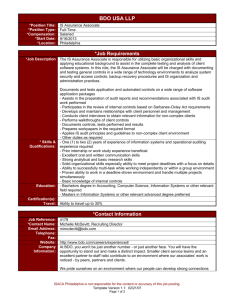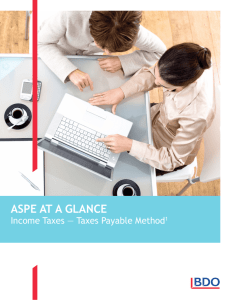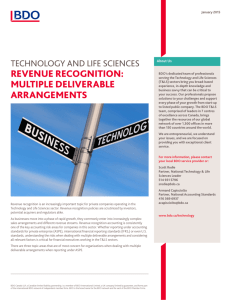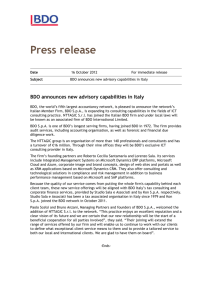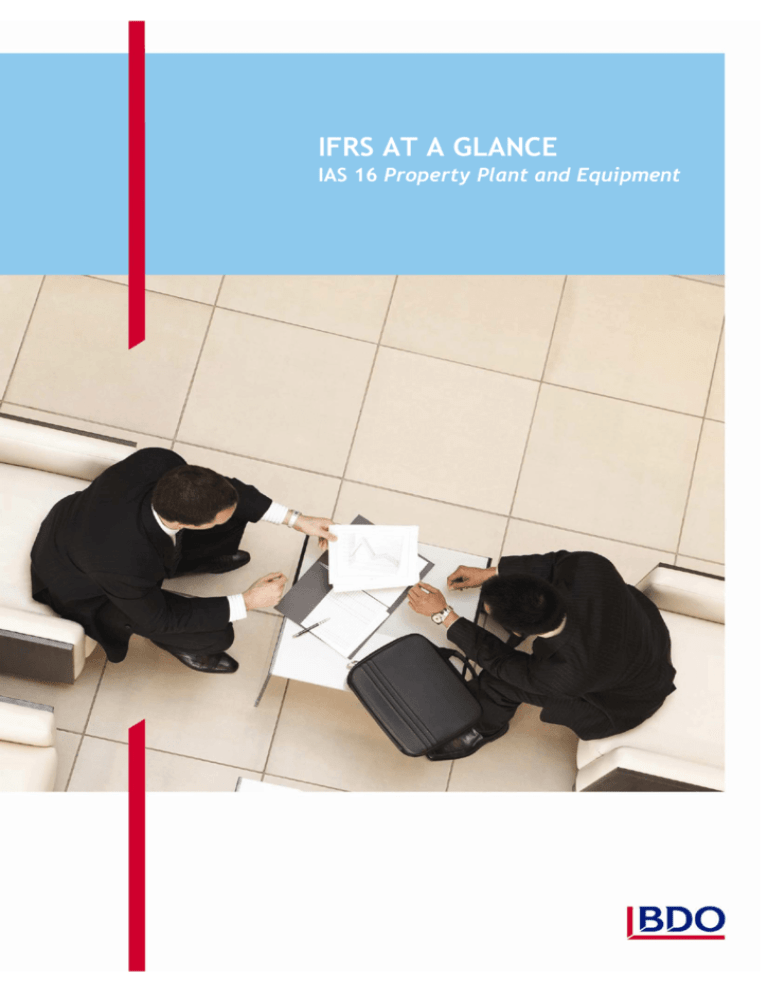
IFRS AT A GLANCE
IAS 16 Property Plant and Equipment
As at 1 July 2015
IAS 16 Property Plant and Equipment
Also refer:
IFRIC 15 Service Concession Arrangements
IFRIC 18 Transfers of Assets to Customers
SIC-29 Disclosure – Service Concession Arrangements
SIC-32 Intangible Assets – Web Site Costs
Effective Date
Periods beginning on or after 1 January 2005
RECOGNITION AND MEASUREMENT
Recognise when it is probable that:
The future economic benefits associated with the asset will flow to the entity; and
The cost of the asset can be reliably measured.
Measurement:
Initially recorded at cost
Subsequent costs are only recognised if costs can be reliably measured and these will lead to additional economic
benefits flowing to the entity.
Cost comprises:
Purchase price plus import duties and taxes
Any costs directly attributable to bringing the asset to the location and condition necessary for it to be
capable of operating in a manner intended by management
The initial estimate of the costs of dismantling and removing the item and restoring the site on which
it is located.
SUBSEQUENT MEASUREMENT
Specific quantitative disclosure requirements:
THE COST MODEL
THE REVALUATION MODEL
The asset is carried at cost less accumulated depreciation and impairment losses.
The asset is carried at a revalued amount, being its fair value at the date of the revaluation, less subsequent
depreciation, provided that fair value can be measured reliably.
Depreciation
The depreciable amount is allocated on a systematic basis over the asset’s useful life
The residual value, the useful life and the depreciation method of an asset are reviewed annually at
reporting date
Changes in residual value, depreciation method and useful life are changes in estimates are accounted for
prospectively in accordance with IAS 8 Accounting Policies, Changes in Accounting Estimates and Errors
Depreciation is charged to profit or loss, unless it is included in the carrying amount of another asset
Depreciation commences when the asset is available for use.
Revaluations should be carried out regularly (the carrying amount of an asset should not differ materially from
its fair value at the reporting date – either higher or lower)
Revaluation frequency depends upon the changes in fair value of the items measured (annual revaluation for
volatile items or intervals between 3 - 5 years for items with less significant changes)
If an item is revalued, the entire class of assets to which that asset belongs is required to be revalued
Revalued assets are depreciated the same way as under the cost model
The net carrying amount of the asset is adjusted to the revalued amount and either
The gross carrying amount is adjusted in a manner consistent with the net carrying amount.
Accumulated depreciation is adjusted to equal the difference between the gross and net carrying
amount; or
Accumulated depreciation is eliminated against the gross carrying amount.
Transfer between reserves – depreciation on revaluation amount
An increase in value is credited to other comprehensive income under the heading revaluation surplus unless it
represents the reversal of a revaluation decrease of the same asset previously recognised as an expense, in
this case the increase in value is recognised in profit or loss.
Amendments to IAS 16 (Effective 1 January 2016)
Revenue based depreciation is prohibited.
Depreciation method reflects the pattern in which future economic benefits are expected to be consumed.
OTHER
Component accounting
Significant parts/components are required to be depreciated over their estimated useful life
Costs of replacing components are required to be capitalised
Continued operation of an item of property, plant and equipment (PPE) may require regular major
inspections for faults regardless of whether parts of the item are replaced. When each major inspection is
performed, its cost is recognised in the carrying amount of the item of PPE as a replacement if the
recognition criteria are satisfied.
Spare parts, stand-by or servicing equipment
Are classified as PPE when they meet the definition of PPE, and are classified as inventory when definition is
not met.
Disposals
Remove the asset from the statement of financial position on disposal or when withdrawn from use and no
future economic benefits are expected from its disposal
The gain or loss on disposal is the difference between the proceeds and the carrying amount and is
recognised in profit or loss
When a revalued asset is disposed of, any revaluation surplus may be transferred directly to retained
earnings. The transfer to retained earnings is not made through profit or loss.
DISCLOSURE
Disclosures include but are not limited to (refer to paragraphs 73 - 79):
Measurement bases used for determining the gross carrying amount
Depreciation methods used
Useful lives or the depreciation rates used
Gross carrying amount and the accumulated depreciation at the beginning and end of the period
A reconciliation of the carrying amount at the beginning and end of the period showing:
additions / assets classified as held for sale or included in a disposal group classified as held for sale / other
disposals / acquisitions through business combinations / changes resulting from revaluations and from
impairment losses recognised or reversed in other comprehensive / impairment losses recognised in profit or
loss / impairment losses reversed in profit or loss / depreciation / exchange differences / other changes.
Existence and amounts of restrictions on title, and PPE pledged as security for liabilities
Contractual commitments for the acquisition of PPE.
For further information about how BDO can assist you and your organisation, please get in touch with one of our key contacts listed below.
Alternatively, please visit www.bdointernational.com/Services/Audit/IFRS/IFRS Country Leaders where you can find full lists of regional and
country contacts.
Europe
Caroline Allouët
Jens Freiberg
Teresa Morahan
Ehud Greenberg
Ruud Vergoossen
Reidar Jensen
Maria Sukonkina
René Krügel
Brian Creighton
France
Germany
Ireland
Israel
Netherlands
Norway
Russia
Switzerland
United Kingdom
caroline.allouet@bdo.fr
jens.freiberg@bdo.de
tmorahan@bdo.ie
ehudg@bdo.co.il
ruud.vergoossen@bdo.nl
reidar.jensen@bdo.no
m.sukonkina@bdo.ru
rene.kruegel@bdo.ch
brian.creighton@bdo.co.uk
Asia Pacific
Wayne Basford
Zheng Xian Hong
Fanny Hsiang
Khoon Yeow Tan
Australia
China
Hong Kong
Malaysia
wayne.basford@bdo.com.au
zheng.xianhong@bdo.com.cn
fannyhsiang@bdo.com.hk
tanky@bdo.my
Latin America
Marcelo Canetti
Luis Pierrend
Ernesto Bartesaghi
Argentina
Peru
Uruguay
mcanetti@bdoargentina.com
lpierrend@bdo.com.pe
ebartesaghi@bdo.com.uy
North America & Caribbean
Armand Capisciolto
Wendy Hambleton
Canada
USA
acapisciolto@bdo.ca
whambleton@bdo.com
Middle East
Arshad Gadit
Antoine Gholam
Bahrain
Lebanon
arshad.gadit@bdo.bh
agholam@bdo-lb.com
Sub Saharan Africa
Nigel Griffith
South Africa
ngriffith@bdo.co.za
This publication has been carefully prepared, but it has been written in general terms and should be seen as broad guidance only. The publication cannot be relied
upon to cover specific situations and you should not act, or refrain from acting, upon the information contained therein without obtaining specific professional
advice. Please contact your respective BDO member firm to discuss these matters in the context of your particular circumstances. Neither BDO IFR Advisory
Limited, Brussels Worldwide Services BVBA, BDO International Limited and/or BDO member firms, nor their respective partners, employees and/or agents accept
or assume any liability or duty of care for any loss arising from any action taken or not taken by anyone in reliance on the information in this publication or for any
decision based on it.
Service provision within the international BDO network of independent member firms (‘the BDO network’) in connection with IFRS (comprising International
Financial Reporting Standards, International Accounting Standards, and Interpretations developed by the IFRS Interpretations Committee and the former Standing
Interpretations Committee), and other documents, as issued by the International Accounting Standards Board, is provided by BDO IFR Advisory Limited, a UK
registered company limited by guarantee. Service provision within the BDO network is coordinated by Brussels Worldwide Services BVBA, a limited liability
company incorporated in Belgium with its statutory seat in Brussels.
Each of BDO International Limited (the governing entity of the BDO network), Brussels Worldwide Services BVBA, BDO IFR Advisory Limited and the member
firms is a separate legal entity and has no liability for another such entity’s acts or omissions. Nothing in the arrangements or rules of the BDO network shall
constitute or imply an agency relationship or a partnership between BDO International Limited, Brussels Worldwide Services BVBA, BDO IFR Advisory Limited and/
or the member firms of the BDO network.
BDO is the brand name for the BDO network and for each of the BDO member firms.
© 2015 BDO IFR Advisory Limited, a UK registered company limited by guarantee. All rights reserved.
www.bdointernational.com

